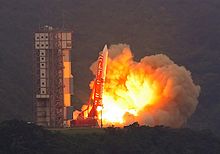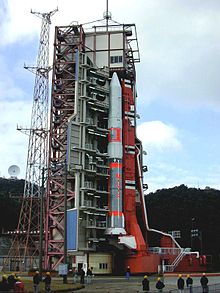
An expendable launch system is a launch vehicle that can be launched only once, after which its components are either destroyed during reentry or discarded in space. ELVs typically consist of several rocket stages that are discarded sequentially as their fuel is exhausted and the vehicle gains altitude and speed. As of 2022, most satellites and human spacecraft are currently launched on ELVs. ELVs are simpler in design than reusable launch systems and therefore may have a lower production cost. Furthermore, an ELV can use its entire fuel supply to accelerate its payload, offering greater payloads. ELVs are proven technology in widespread use for many decades.
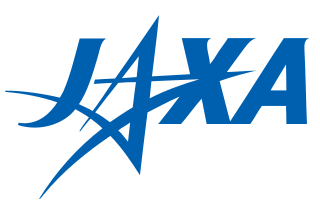
The Japan Aerospace Exploration Agency (JAXA) is the Japanese national air and space agency. Through the merger of three previously independent organizations, JAXA was formed on 1 October 2003. JAXA is responsible for research, technology development and launch of satellites into orbit, and is involved in many more advanced missions such as asteroid exploration and possible human exploration of the Moon. Its motto is One JAXA and its corporate slogan is Explore to Realize.
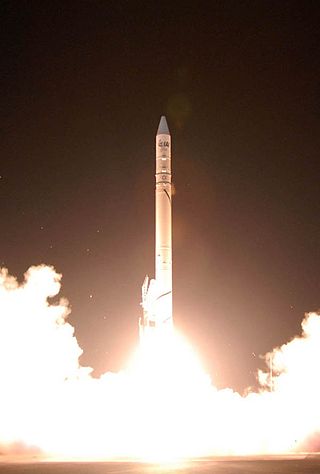
Shavit 2 is a small lift launch vehicle produced by Israel from 1982 onwards, to launch satellites into low Earth orbit. It was first launched on 19 September 1988, making Israel the eighth nation to have an orbital launch capability after the USSR, United States, France, Japan, People's Republic of China, United Kingdom, and India.

H-IIA (H-2A) is an active expendable launch system operated by Mitsubishi Heavy Industries (MHI) for the Japan Aerospace Exploration Agency. These liquid fuel rockets have been used to launch satellites into geostationary orbit; lunar orbiting spacecraft; Akatsuki, which studied the planet Venus; and the Emirates Mars Mission, which was launched to Mars in July 2020. Launches occur at the Tanegashima Space Center. The H-IIA first flew in 2001. As of February 2024, H-IIA rockets were launched 48 times, including 42 consecutive missions without a failure, dating back to 29 November 2003.

The Uchinoura Space Center is a space launch facility in the Japanese town of Kimotsuki, Kagoshima Prefecture. Before the establishment of the JAXA space agency in 2003, it was simply called the Kagoshima Space Center (鹿児島宇宙空間観測所) (KSC). All of Japan's scientific satellites were launched from Uchinoura prior to the M-V launch vehicles being decommissioned in 2006. It continues to be used for suborbital launches, stratospheric balloons and has also been used for the Epsilon orbital launch vehicle. Additionally, the center has antennas for communication with interplanetary space probes.

The Mu, also known as M, was a series of Japanese solid-fueled carrier rockets, which were launched from Uchinoura between 1966 and 2006. Originally developed by Japan's Institute of Space and Astronautical Science, Mu rockets were later operated by Japan Aerospace Exploration Agency following ISAS becoming part of it.
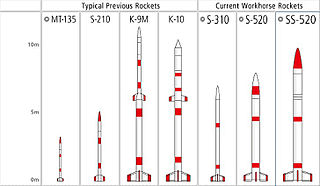
S-Series is a fleet of sounding rockets funded by the Japan Aerospace Exploration Agency (JAXA) that have been in service since the late 1960s. Manufactured by IHI Aerospace and operated by the Institute of Space and Astronautical Science (ISAS). The nomenclature of the S-Series rockets is the number of "S"s indicates the number of stages, and the following number details the diameter of the craft in millimeters. For example, the S-310 is a single stage rocket with a diameter of 310 mm.

HALCA, also known for its project name VSOP, the code name MUSES-B, or just Haruka (はるか) was a Japanese 8 meter diameter radio telescope satellite which was used for Very Long Baseline Interferometry (VLBI). It was the first such space-borne dedicated VLBI mission.
Institute of Space and Astronautical Science, or ISAS, is a Japanese national research organization of astrophysics using rockets, astronomical satellites and interplanetary probes which played a major role in Japan's space development. Since 2003, it is a division of Japan Aerospace Exploration Agency (JAXA).

Minotaur-C, formerly known as Taurus or Taurus XL, is a four stage solid fueled launch vehicle built in the United States by Orbital Sciences and launched from SLC-576E at California's Vandenberg Air Force Base. It is based on the air-launched Pegasus rocket from the same manufacturer, utilizing a "zeroth stage" in place of an airplane. The Minotaur-C is able to carry a maximum payload of around 1458 kg into a low Earth orbit (LEO).

H-IIB (H2B) was an expendable space launch system jointly developed by the Japanese government's space agency JAXA and Mitsubishi Heavy Industries. It was used to launch the H-II Transfer Vehicle cargo spacecraft for the International Space Station. The H-IIB was a liquid-fueled rocket, with solid-fuel strap-on boosters and was launched from the Tanegashima Space Center in southern Japan. H-IIB made its first flight in 2009, and had made a total of nine flights through 2020 with no failures.

The Minotaur is a family of United States solid fuel launch vehicles derived from converted Minuteman and Peacekeeper intercontinental ballistic missiles (ICBM). They are built by Northrop Grumman via contract with the Air Force Space and Missile Systems Center's Space Development and Test Directorate (SMC/SD) as part of the Air Force's Rocket Systems Launch Program which converts retired Intercontinental Ballistic Missiles into space and test launch systems for U.S. government agencies.
The J-I was a Solid-fuel rocket expendable launch vehicle developed by the National Space Development Agency of Japan and the Institute of Space and Astronautical Science. In an attempt to reduce development costs, it used the solid rocket booster from the H-II as the first stage, and the upper stages of the M-3SII. It flew only once on a suborbital flight taking place 11 February 1996 UTC from Tanegashima Space Center pad LA-N, in a partial configuration, to launch the demonstrator HYFLEX. The vehicle never flew in the final orbital capability configuration, which should have launched the OICETS satellite.

Castor is a family of solid-fuel rocket stages and boosters built by Thiokol and used on a variety of launch vehicles. They were initially developed as the second-stage motor of the Scout rocket. The design was based on the MGM-29 Sergeant, a surface-to-surface missile developed for the United States Army at the Jet Propulsion Laboratory.
The Institute for Unmanned Space Experiment Free Flyer (USEF) (財団法人無人宇宙実験システム研究開発機構) was a Japanese space agency, which was founded by the Ministry of International Trade and Industry in 1986. Unlike NASDA, ISAS, and NAL, it was not included in the JAXA organization, which was founded in 2003. The chairperson is Ichiro Taniguchi.

The Japanese space program originated in the mid-1950s as a research group led by Hideo Itokawa at the University of Tokyo. The size of the rockets produced gradually increased from under 30 cm (12 in) at the start of the project, to over 15 m (49 ft) by the mid-1960s. The aim of the original research project was to launch a man-made satellite.

The Epsilon Launch Vehicle, or Epsilon rocket, is a Japanese solid-fuel rocket designed to launch scientific satellites. It is a follow-on project to the larger and more expensive M-V rocket which was retired in 2006. The Japan Aerospace Exploration Agency (JAXA) began developing the Epsilon in 2007. It is capable of placing a 590 kg payload into Sun-synchronous orbit.

The H3 Launch Vehicle is a Japanese expendable launch system. H3 launch vehicles are liquid-propellant rockets with strap-on solid rocket boosters and are launched from Tanegashima Space Center in Japan. Mitsubishi Heavy Industries (MHI) and JAXA are responsible for the design, manufacture, and operation of the H3. The H3 is the world's first rocket to use an expander bleed cycle for the first stage engine.

A small-lift launch vehicle is a rocket orbital launch vehicle that is capable of lifting 2,000 kg (4,400 lb) or less or under 5,000 kilograms (11,000 lb) of payload into low Earth orbit (LEO). The next larger category consists of medium-lift launch vehicles.
SRB-A is a series of Japanese solid-fueled rocket booster manufactured by IHI Corporation for use on the H-IIA, H-IIB, and Epsilon rockets.
